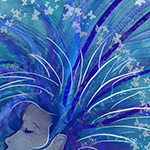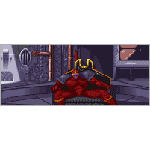|
mutata posted:While this is fair to ask, your reaction is a very narrow oversimplification to a very complex question. We as artists should be careful not to assume that other people are creating for the same reasons that we are creating or that our reasons are the most valid reasons or the best, etc. Why someone is drawn to a certain activity; why we feel compelled to do ANYTHING at all is a very complex web of conscious and unconscious reasons. Hell, over the course of time, a single individual can create different things for entirely different reasons. To answer your question hallo spacedog, this is pretty much it, except substitute in 3D rendering or pixel art animation for painting. I don't care for drawings even by very skilled people, but I love animation and highly polished digital art. The fuzziness of drawing drives me up the wall, but I know I have to learn how before I can move on to other media. Can't swordfight if you don't know how to hold a stick!
|
|
|
|

|
| # ? Apr 24, 2024 11:17 |
|
TwoQuestions posted:To answer your question hallo spacedog, this is pretty much it, except substitute in 3D rendering or pixel art animation for painting. I don't care for drawings even by very skilled people, but I love animation and highly polished digital art. The fuzziness of drawing drives me up the wall, but I know I have to learn how before I can move on to other media. Can't swordfight if you don't know how to hold a stick! I don't know, to me this seems kinda like forcing yourself to learn to play piano in order to eventually be a good guitarist. I think you'd probably be better off just learning 3D rendering and pixel art if that's what interests you and it's what you want to do, especially if you're not into traditional art on any level. I've practiced drawing on and off with varying degrees of commitment since I was a kid and now at 29 I'm finally starting to get the results I've always wanted, but if you asked me to do some 3D rendering or pixel art I'd go in thinking of myself as a total beginner.
|
|
|
|
Do you actually hate drawing, or do you simply expect to hate drawing, or perhaps hate drawing because your self-imposed rules force you to draw uninteresting basic objects over and over again?
|
|
|
|
Fangz posted:Do you actually hate drawing, or do you simply expect to hate drawing, or perhaps hate drawing because your self-imposed rules force you to draw uninteresting basic objects over and over again? I figured learning how to do draw/do art would be like learning how to play an instrument or exercise where the beginning is mega-painful, but it gets less so after a bit. I think I'm starting to get past that beginning point, as I can tell what the subjects of my drawings are usually. Even simple objects become interesting when I try to depict every last detail of it, including the labels on a soda can and the lid of a hand sanitizer bottle. Avril Lavigne posted:I don't know, to me this seems kinda like forcing yourself to learn to play piano in order to eventually be a good guitarist. I think you'd probably be better off just learning 3D rendering and pixel art if that's what interests you and it's what you want to do, especially if you're not into traditional art on any level. I've practiced drawing on and off with varying degrees of commitment since I was a kid and now at 29 I'm finally starting to get the results I've always wanted, but if you asked me to do some 3D rendering or pixel art I'd go in thinking of myself as a total beginner. I wish that were true, but every visual medium I've looked at doing recommends you learn to draw first. Yay for foundational studies. I also just bought an extra large ream of cheapass printer paper and a clipboard, and I intend to use them!
|
|
|
|
Avril Lavigne posted:I don't know, to me this seems kinda like forcing yourself to learn to play piano in order to eventually be a good guitarist. This is just, like, my opinion, maaan, but that's a good comparison because both of them are good ideas. You start out learning the piano not because a piano is fundamental to all other instruments, but because when you're learning theory, it's best to stick with the easiest instrument on which to visualize the theory. Pianos are excellent for learning music theory because they're linear - every time you go up a key, you go up half a step on the scale. Guitars, for example, are more difficult in this regard, because there's more than one way to play many notes, and playing a guitar properly involves knowing many if not all of them. Likewise, drawing is the most accessible way to learn art theory. It happens to be true that it is fundamental to most other art forms; I know of no painters (in physical media, anyway), for example, who don't first draw their subjects. But it's also much easier and more accessible to pick up a pencil and a sheet of paper and begin learning perspective or shape construction than it is to find paint and an easel, or marble and a chisel, or what have you. Further, unlike painting or sculpting or 3D modeling, once you know how to draw, you can sketch your ideas pretty much anywhere and then transfer them to your desired medium later - much like how many musicians figure out their melodies and harmonies on piano and then transfer to the instrument they prefer to play.
|
|
|
|
beats posted:While you're absolutely right there is no quick-fix book/trick out there, you'd really be doing yourself a disservice to neglect the wealth of information and insights that are out there - both on specific techniques and the broader aspects of art. Fair points, maybe I've just not come across the right book - they all seem to have a ton of chaff for every unique/useful idea. I'm not saying 'reading is bad', just that 'reading instead of drawing is bad, and I found it easy to get sucked into that starting out'. As a supplement, sure, but that's assuming a bigass time commitment from someone just starting out. Plus, paper/pencil is a way cheaper investment. Unless the book has 'manga' or 'chris hart' in the title, in which case just burn it.  e: As a supplement, I'd still recommend videos (Proko, etc) over books for someone starting out - free, faster, more engaging, and can show the process as well as the end result. Woo, living in the future! petrol blue fucked around with this message at 00:53 on Sep 11, 2014 |
|
|
|
Besesoth posted:This is just, like, my opinion, maaan, but that's a good comparison because both of them are good ideas. Very good points! The main intention of my comparison was just that I think it's a lot harder to stay enthusiastic and motivated when learning something you don't have a real passion for, as opposed to learning something that excites you enough to keep you interested & not seem like a chore.
|
|
|
|
Avril Lavigne posted:Very good points! The main intention of my comparison was just that I think it's a lot harder to stay enthusiastic and motivated when learning something you don't have a real passion for, as opposed to learning something that excites you enough to keep you interested & not seem like a chore. That's basically my point too. I don't care either way but personally I don't think the pain of practicing some kind of instrument that I hate would ever be worth it for me even if I had some kind of momentary desire to learn music or whatever because I really don't like that stuff but that's just my feeling. Like I get the idea of wanting to learn drawing to paint but I can't imagine enjoying painting, but hating drawing. How does that even work?
|
|
|
|
I love drawing and hate painting.
|
|
|
|
mutata posted:I love drawing and hate painting. So do I but I can't imagine the other way around. I guess if you like 3d and pixel art you should do them as much as you can. You also won't know either unless you do those things. If you spend a whole lot of time working on forcing yourself to draw cups before you bother trying to make pixel art and then you hate the process of doing that too it will have wasted a lot of your time. Also, you can love looking at something and appreciate the poo poo out of it but not be inclined to actually do it. Lots of people who love listening to music and watching film probably fit into that category. If this sounds like I'm discouraging you I don't mean it. Opposed to that I am actually encouraging you to at least try the things you want to do even while you are trying to build basic skills because for all you know you could hate actually doing them. I don't think art basics have to be a walk before run kind of thing. If you want to sculpt or paint or make prints then gently caress it, do a ton of those badly while drawing poo poo cups too, there's nothing stopping you and also drawing loving amazing photo realistic cups will not help you sculpt better if you haven't done it. hallo spacedog fucked around with this message at 02:32 on Sep 11, 2014 |
|
|
|
Are landscapes a good thing to try to draw as a beginner, or should I just pick something out and draw that if I'm at the park or something? drat I'm sick of drawing this hand sanitizer bottle.
|
|
|
|
Keep going with Drawing on the Right Side of the Brain, because when you say this:TwoQuestions posted:I'm sticking with simple stuff right now because that's all I can put to paper and have it be recognizable as the subject. I see what the students in Drawing on the Right Side of the Brain are able to do, and I practice with something easy until I can get to their level. It sounds to me like you've put it aside while you get your skills up to scratch, when the whole point of the book is to get your skills up to where her students were by doing the same things she taught them. She also stresses that being able to draw means being able to draw anything, be it landscape, object or person, so asking about what to draw implies you haven't read too far yet. It's all about core skills that come into play in everything you do, not any specific subject. In any case, the correct thing to draw is whatever you find interesting. If you want to try some illustration, start by doing some Loomis heads, as they're a quick and easy way of drawing something extremely relevant and in a satisfyingly accurate way. Start by watching this playlist from start to finish - it'll only take 17 mins or so. Then go back to the start and pause it at the appropriate points so you can draw along with him. Try drawing some heads of your own once you're done, all at different angles. By the end you'll have a bunch of basic human heads that you can add features to, and as long as you draw the facial features in relation to the lines you've drawn, you can draw them as crappily as you like and they'll still look 'right', because the symmetry, proportions and perspective will all be in place. I found it to be a really good way of boosting my confidence, because even in an incomplete state they make good, consistent artwork seem perfectly attainable. Doctor_Fruitbat fucked around with this message at 22:59 on Sep 11, 2014 |
|
|
|
TwoQuestions posted:Are landscapes a good thing to try to draw as a beginner, or should I just pick something out and draw that if I'm at the park or something? I mean this in the nicest way possible but seriously, just try drawing literally anything. Landscapes, a thing in a park, a face a dog a car whatever. You aren't going to somehow mystically ruin your learning process by drawing something different and badly. Literally draw anything. Just draw. Honestly even just making a bunch of lines or circles on a piece of paper would help you. You're overthinking this by a lot. ...actually if you are worried about just drawing, maybe it would be good to just make a lot of marks on a paper so you don't feel bad about starting anymore.
|
|
|
|
Landscapes are fine. Anything from life is fine. It's less what you draw specifically, and more about developing the ability to see. Also, everything hallo spacedog said. Do that.
|
|
|
|
I think I figured out what I'm really getting hung up on. Last Saturday I drew a picture of my cell phone resting on a saucer, and the angular shape of the cell phone was pretty good but the circular shape of the saucer was pretty bad. What would you people recommend I do to improve my terrible ovals and circles? I feel like I'm spinning my wheels just drawing a bunch of balls and cups, or should I just keep doing that?
|
|
|
|
If you're struggling to draw circles, draw circles more. My experience is that 90% of art is figuring out what you suck at, then practising it till you stop sucking at it.
|
|
|
|
TwoQuestions posted:I think I figured out what I'm really getting hung up on. Last Saturday I drew a picture of my cell phone resting on a saucer, and the angular shape of the cell phone was pretty good but the circular shape of the saucer was pretty bad. Circles, Ellipses and Straight Lines are extremely difficult and honestly can take years to learn to do them very well. Bright side, if you have the control to produce perfect ellipses on command, you can draw pretty much anything. As Petrol Blue said though, the only way to get better at these is to practice them. If you want something more thorough than that, this video covers some ways to practice basic shapes/lines/circles if you are completely lost. http://www.youtube.com/watch?v=3971zJW9VHI
|
|
|
|
JuniperCake posted:Circles, Ellipses and Straight Lines are extremely difficult and honestly can take years to learn to do them very well. Bright side, if you have the control to produce perfect ellipses on command, you can draw pretty much anything. Bookmarked, thank you much!
|
|
|
|
JuniperCake posted:Circles, Ellipses and Straight Lines are extremely difficult and honestly can take years to learn to do them very well. Bright side, if you have the control to produce perfect ellipses on command, you can draw pretty much anything. Watched this over lunch, and that's exactly what I was looking for. Now I know where my evening's going... EDIT: And holy poo poo I can't make a straight mark to save my life! TwoQuestions fucked around with this message at 04:02 on Sep 17, 2014 |
|
|
|
Got a link that some people might be interested in. These are plates from Charles Bargue's Atelier in the 1800s. If anyone is bored and likes traditional exercises these are pretty dang good. Might be a nice break from drawing ellipses anyways. https://plus.google.com/photos/104620822473004383244/albums/5471538774867871409 Classical statues are really cool for drawing practice in general. Also check out Bargue's paintings if you ever get a chance, the amount of detail in those things is absolutely obscene.
|
|
|
|
Trip report from learning to make marks better, I've found that simply drilling straight lines is boring and frustrating as hell, and simply drawing things trains both your eye and you get the line practice you need at the same time. In other news, I drew my keys during a D&D game, and I asked one of the players (who's also an art major) how to make the largest key 'pop' better, and everyone was impressed at my 30 minute drawing. I also find it's easier to concentrate on what someone's saying while drawing than just staring off into space, which was quite unexpected.
|
|
|
|
A lot of the hard part of drawing good circles/lines/ellipses is figuring out a good rhythm for your arm and shoulder and learning to replicate it consistently. Try holding the pencil/pen a few different ways and drawing from different angles on the paper to figure out what works best for you. Don't forget to warm up before trying to draw an actual circle for a more complex drawing, either. My circles tend to look a lot better after even just five minutes of doing some basic practice circles beforehand.
|
|
|
|
TwoQuestions posted:I also find it's easier to concentrate on what someone's saying while drawing than just staring off into space, which was quite unexpected. I know what you mean, I'm very similar. I've been listening to a ton of podcasts while drawing, and it works far better than I'd expect. Maybe because you're not distracted with working out a clever response, etc.
|
|
|
|
petrol blue posted:I know what you mean, I'm very similar. I've been listening to a ton of podcasts while drawing, and it works far better than I'd expect. Maybe because you're not distracted with working out a clever response, etc. I'll have to try that! The author of Drawing on the Right Side of the brain says it's distracting, so I never tried that! Perhaps giving the 'left' brain something completely unrelated to concentrate on so it can avoid trying to interpret what's coming in the eyeballs.
|
|
|
|
My take on it in terms of the 'sides of brain' thing is that listening to speech occupies the part of your brain that deals in language (which also tends to be the bit that thinks "That is a leaf. I know what 'leaf' is, I have a handy symbol for 'leaf', let's draw the leaf-symbol." I think I can hear my old psych lecturer spinning in his grave if I listen carefully...
|
|
|
|
I got an intuos 4 for my birthday a few months ago by someone who apparently overestimated my artistic talent. I used it a couple of times and realised I was useless (my drawing ability is like a 4 yr olds) so it has been sitting in a cupboard since. However, now I want to express myself through art!!! or actually use this fairly expensive gift someone bought me or something. Should I start with digital painting? I did a little bit of reading and I'm thinking it might be better to just sit with pencil and paper drawing from life until I can get the lines where I want them to go. Is this the best way to go? Is there a decent step by step guide somewhere starting from nothing? I am more interested in painting than drawing, although illustration is cool. And if I dedicated, say, 20-30 minutes a day to practicing realistically how long would it take before I could output something decent? My metric for decent would be a home made christmas card where the recipient wouldn't think I was taking the piss. I'm into surreal and I guess kind of dark stuff, Esao Andrews is one of my favourite artists, and while I have no expectations of being anywhere as good that's the kind of stuff I'd ultimately want to paint (and yeah i get that would take more than a few years). Or, should I just sell the tablet and move on. I am actually interested in art and would like to be good at it but my skill is literally 0 (haven't put pencil to paper in years) but if it's going to take 2 years to make a christmas card I might just give up now. Although I could probably up the 30 mins a day depending on how busy the next year turns out to be.
|
|
|
|
Crack posted:
A lot of people say it is better to start traditional (black and white pencil/charcoal on paper) because it simplifies things. Usually it feels better to draw on paper than on a tablet, and it prevents you from depending on short cuts like ctrl+z that could lead to bad habits. That said, fundamentals can be learned in pretty much any medium and so it wouldn't be the end of the world to start digital. Telling you how long will take will be fairly impossible. You'll see your first rapid improvements once you learn how to truly see what you are drawing, and not just draw symbols or what you assume it must look like. This doesn't have to take a long time but the time it takes for this to "click" is definitely different based on the person. To help your chances, draw from life. What you draw doesn't matter, just draw a physical object or living being near you and spend more time looking at them then the paper/tablet. Your plan of 20-30 min a day is good though. Biggest thing with picking up drawing is just actually getting a good drawing habit and sticking with it. It's better to draw a little every day then do binges and then stop drawing for long periods of time. Who knows if you get hooked, 20-30 min can become 4-6 hours. So go for it. Imo since you have the tablet try it out a bit but maybe start with greyscale black/white and draw from life. You don't even know if you'll like drawing until you've practiced a bit so just have fun with it and experiment with it. Try some grayscale drawings and draw stuff around you that you like. If you find that you really like it after some time, maybe then pick up some charcoal/newsprint or pencils/copy paper and mix some traditional in with your digital.
|
|
|
|
Cheap-rear end copy paper is beautiful for learning how to draw. For the price of a 50-page sketchbook, you can get 750 pages of printer paper and not care about how many mistakes you make. Just draw a ton of stuff, and one day you'll still see the crappiness of your drawings but other people will be amazed, and you'll be amazed after you spend 30 minutes not looking at it. Draw a ton, and don't worry about quality too much. You'll fix it automatically, and before you know it you'll go from "total poo poo" to "pretty good"!
|
|
|
|
Thanks for the replies! I think I will start traditional and mix in a bit of digital to get some colour occasionally. Maybe it was a poor choice, but I just tried to do a line drawing water bottle and it looks extremely wrong. I have no idea of how to deal with transparency. Maybe it's because my drawing was too flat or something. All I have is an HB pencil by the way, is it possible to make the bottle 3d without shading the whole thing? And there's reflections in the plastic... E: also is there a go-to guide for setting up photoshop for drawing/painting?
|
|
|
|
Crack posted:I got an intuos 4 for my birthday a few months ago by someone who apparently overestimated my artistic talent. I used it a couple of times and realised I was useless (my drawing ability is like a 4 yr olds) so it has been sitting in a cupboard since. I'm only an amateur artist, but I'd say do both. Drawing from observation with good 'ol graphite is the bread and butter of visual art, any artist of any skill level working in any medium benefits from practicing it. At the same time, don't stop your self from doing whatever art stuff you find interesting, because that's whats going to keep you making art. In my experience, the fine motorskills you develop for traditional media just don't translate over into using a digital tablet. They have a completely different feel and you'll only learn to control a tablet by using a tablet. However in order to draw or paint you need to have a really detailed understanding of how things like form, perspective, color, light, anatomy, and a bunch of other stuff actually work. Its the more difficult and valuable skill set to develop, and you should be able to carry it into any medium you decide to work in. As for how much progress you can make, nobody can really give you an exact figure, but you will improve. Dedication towards constantly improving your craft is probably the single most important thing an artist can do, its certainly the trait I envy most in other artists. Here are a few before/after pictures from new students drawing like crazy over 5 days with an instructor, from the ever popular Drawing on the Right Side of the Brain book. Most people aren't going to work at that grueling pace, but they demonstrate the quick gains JuniperCake mentioned where you "learn to see" what you're drawing.  TwoQuestions posted:Cheap-rear end copy paper is beautiful for learning how to draw. For the price of a 50-page sketchbook, you can get 750 pages of printer paper and not care about how many mistakes you make. Just draw a ton of stuff, and one day you'll still see the crappiness of your drawings but other people will be amazed, and you'll be amazed after you spend 30 minutes not looking at it. Drawing on copy paper isn't bad, but it does have its limitations. Probably like most people, up through high-school I drew almost exclusively on copy paper. I liked drawing mostly mechanical stuff with a mechanical pencil and I worked exclusively in line. Then I got to college and took a drawing course where working on a big pad of 24" x 18" paper was the standard, and it was a completely different experience. I started out drawing like I did before, until the instructor laughed and asked why I was drawing so small when I had this whole big sheet to work with. Instead of using just my wrist and fingers to draw, I had to start using my elbow and shoulder, and holding the pencil in new ways. The tooth on the paper let me play with value by using charcoal or lots of graphite, which would just slide off copy paper. I still like all the stuff I liked before, but now I also like drawing organic forms and working with super soft 9B pencils and charcoal and going at things with big sticks of graphite. When using any material make sure its because you've decided its your best tool for the job, not because its the only thing you know.
|
|
|
|
OtherworldlyInvader posted:Drawing on copy paper isn't bad, but it does have its limitations. Probably like most people, up through high-school I drew almost exclusively on copy paper. I liked drawing mostly mechanical stuff with a mechanical pencil and I worked exclusively in line. Then I got to college and took a drawing course where working on a big pad of 24" x 18" paper was the standard, and it was a completely different experience. I started out drawing like I did before, until the instructor laughed and asked why I was drawing so small when I had this whole big sheet to work with. Instead of using just my wrist and fingers to draw, I had to start using my elbow and shoulder, and holding the pencil in new ways. The tooth on the paper let me play with value by using charcoal or lots of graphite, which would just slide off copy paper. I still like all the stuff I liked before, but now I also like drawing organic forms and working with super soft 9B pencils and charcoal and going at things with big sticks of graphite. When using any material make sure its because you've decided its your best tool for the job, not because its the only thing you know. Is the difference really that great to a total beginner? I understand an art student or someone else who draws for their 9-5 can probably tell the difference between two seemingly identical pencils by feel alone, but it feels like overkill for someone learning the very basics.
|
|
|
|
I would recommend copy paper to a beginner for the mental benefits alone.
|
|
|
|
Personally I found it really useful. At that point my art experience was "doodled in class, occasionally drew some video game fan art and spaceships on my own time", which is about where most people are in an intro drawing course. Really the argument I'm trying to make is to just periodically try new things, because you'll discover new things you like. For some people, "trying new things" is drawing anything at all.
|
|
|
|
I also did the 18x24 with 4-6B charcoal route (I don't like graphite for large paper unless you are doing something technical with lots of hard edges like buildings, some vehicles, etc but this is a personal thing) and I'd say it has a lot to recommend for it. Just being able to take a few steps back to see your work as well as being able to use your whole arm for flow-y strokes that you just can't achieve with the wrist alone is worth it. In my opinion, this is the best way to learn the fundamentals. If you do nothing else, do at least one 3 hour + life drawing session a week with a model. It's also nice to make art in a group environment, you can share in the struggles of difficult poses (thats another benefit of lifedrawing, you get thrown interesting poses with foreshortening that you might not encounter if you just draw a bunch of faces in profile or whatever all day) and just support each other and socialize. It even gets relaxing in a way with the longer poses. But yeah something like this is definitely not required but I'd hugely recommend trying it at least once for six months (give yourself time to acclimate before you decide its for you or not) if you are thinking of making art a huge part of your life. Also dont worry about making a fool of yourself. Everyone starts somewhere and I have been in many life drawing classes and I have never been in one where people are hostile to new artists. People like to see others succeed and they'll help you out.
|
|
|
|
mutata posted:I would recommend copy paper to a beginner for the mental benefits alone. Seconded. I've still got a load of 'nice' pads that never get touched, because might waste nice paper, etc. Meanwhile I'll happily chew through reams of copy paper, there isn't the same pressure (all imagined, I know) to make it 'worth it'.
|
|
|
|
OtherworldlyInvader posted:In my experience, the fine motorskills you develop for traditional media just don't translate over into using a digital tablet. They have a completely different feel and you'll only learn to control a tablet by using a tablet. Moderately expensive tip here (those nibs don't run cheap, man): try taping a piece of printer paper on your drawing surface. It grinds down your nib like hella, but it improves your stability by a ton without resorting to using inbuilt stabilizers which only hurt your skills in the long run.
|
|
|
|
18 x 24 newsprint and Conte pencils is what really did it for me in terms of really learning to draw. Drawing big and letting the material glide over the paper will allow you to draw big, fluid lines. Since newsprint is so cheap, I don't feel bad about flipping the page over on bad starts. Sure it's not archival, but who cares, you're not going to create a masterpiece right out of the gate. Newsprint is super cheap and the smooth stuff won't fight you. I like to buy this one in particular because it's super cheap, smooth, and will get you tons of mileage: http://www.dickblick.com/products/blick-all-purpose-newsprint/ While you're at it, buy a box of B or 2B Conte Pierre Noir (black) pencils, some large binder clips to hold the paper in place on your drawing board, a knife or box of razor blades, and some sandpaper to sharpen your pencils nicely. If you have a lumber yard nearby, ask if they can cut down a scrap piece of particle / MDF board to 20 x 24 for your drawing board - I got mine for just 5 bucks. I left a couple of inches on the bottom because I usually sit the board on my lap and rest it against a table/table/drawing horse and I didn't want the bottom of the paper pushing up from my lap. All of that would cost you somewhere between $30-$50 and you'd get months of mileage out of it.
|
|
|
|
Billy Shears posted:
Yeah, Newsprint is super cheap and so are most traditional drawing supplies like charcoal, graphite and conte. I prefer the sticks over the pencils but whichever you use make sure you always keep it sharpened. You ideally want a good tip for lines but also want the charcoal to have nicely rounded sides at the top so you can use the sides of it for shading. You can also get clips for your board if you want to put it on an easel or just use tape if you are going to be working for a long time on a piece of paper and you are using a nicer quality than newsprint. So cost shouldn't really be a factor here. Can always do both as well. Copy paper at home, newsprint when you go out for a life drawing session.
|
|
|
|
While this all sounds like excellent advice, I'm a poor as gently caress student and I really don't want to spend any more money than necessary. I don't want to pay for life drawing classes, and I don't have the space for massive sheets of paper, or a board to put it on. What I have is: an Intuos 4 with photoshop, a set of drawing pencils (6B to 4H), some lined A4 paper and a flat desk. I'm aware this limits me somewhat, but am I really going to be unable to improve that much unless I buy meters of special paper, an easel, 12 shades of charcoal and go to drawing classes? All I want to do in the short term is paint a reasonable representation of my mothers cat to put on a birthday card. Longer term it would be cool to do surreal masterpieces but I'm really trying to plan for the former.
|
|
|
|

|
| # ? Apr 24, 2024 11:17 |
|
I think the point of the news print is that it's the biggest amount of paper you can get for dirt cheap. Having said that, copy paper is a lot easier to get. Lined is fine, as long as you can live with occaisionally doing something you're proud of and then sulking cos it's spoiled a bit by lines. Figure classes are nice, but there's sites that aim to do the same thing for free. Youtube has more tutorials that you can shake a stick at if you want them, Proko is pretty good. If I was in your situation, I'd put the tablet aside for a bit - drawing is hard enough without the added handicap of the line appearing somewhere else. First, watch this gesture tutorial. Then, set aside a certain time every/most days where you Art for an hour, put on one of those sites I linked to and some music (the second one even has a 'class' mode!), give it a couple months, and then look at the tablet again. Having said that, no reason you couldn't start with the tablet, but it'd mean you have a lot more to learn up-front, so you might not see results as fast/consistently. e: Or mix it up a bit. The worst that happens is that you don't learn 'as efficiently', so there's nothing to worry about. petrol blue fucked around with this message at 00:32 on Sep 28, 2014 |
|
|






















